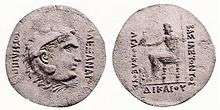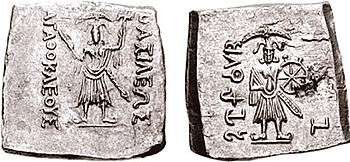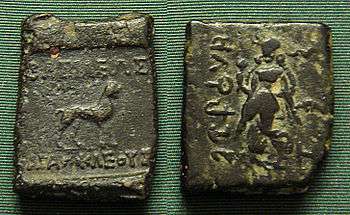Agathocles of Bactria
| Agathocles "the Just" (Δίκαιος) | |
|---|---|
| Indo-Greek king | |
|
| |
| Reign | 190–180 BC |
Agathocles Dikaios (Greek: Ἀγαθοκλῆς ὁ Δίκαιος; epithet meaning: "the Just") was a Greco-Bactrian/ Indo-Greek king, who reigned between around 190 and 180 BC. He might have been a son of Demetrius and one of his sub-kings in charge of the Paropamisade between Bactria and India. In that case, he was a grandson of Euthydemus whom he qualified on his coins as Βασιλεὺς Θεός, Basileus Theos (Greek for "God-King").
Agathocles was contemporary with or a successor of king Pantaleon. He seems to have been attacked and killed by the usurper Eucratides, who took control of the Greco-Bactrian territory. Little is known about him, apart from his extensive coinage.
Pedigree coinage
Agathocles issued a series of "pedigree" dynastic coins, probably with the intent to advertise his lineage and legitimize his rule, linking him to Alexander the Great, a king Antiochus Nikator (Greek: "Νικάτωρ" "Victorious", probably intended is Antiochus III), the founder of the Greco-Bactrian kingdom Diodotus and his son Diodotus II, Euthydemus, Pantaleon, and Demetrius.
Dynast or usurper?
Obv: – Greek inscription reads: ΔΗΜΗΤΡΙΟΥ ΑΝΙΚΗΤΟΥ i.e. "of Demetrius the Invincible".
The pedigree coinage has been seen as a token of his ancestry, but a critical view might be considered. All the associations provide a contradictory image. The Euthydemid kings (Demetrius and Euthydemus) are not known to be related to Diodotus – in fact, Euthydemus I overthrew Diodotus II! The Seleucids were enemies of the Euthydemids as well – in fact king Antiochus III had besieged Bactra for almost three years before claiming victory over Euthydemus I. Nevertheless, Antiochus III is known to have used the epithet "Nikator" ("Νικάτωρ" Greek for "Victorious")[2]
Finally, the association with Alexander was a standard move for usurpers in the Hellenistic world, such as the pseudo-Seleucids Alexander Balas and the Syrian general Diodotus Tryphon.
All in all, the coins might well support the view of a usurper, or more probable a member of a minor branch of a dynasty, anxious to gather support from all quarters with his various memorial coins. However, the similarities between his coinage and that of Pantaleon make it probable that Agathocles was indeed a relative of the latter, who in that case might have been a usurper as well.

- I) Pedigree coin of Agathocles with Alexander the Great.
Obverse – Greek inscription reads: ΑΛΕΞΑΝΔΡΟΥ ΤΟΥ ΦΙΛΙΠΠΟΥ i.e. "of Alexander son of Philip".
Reverse – Greek inscription reads: ΒΑΣΙΛΕΥΟΝΤΟΣ ΑΓΑΘΟΚΛΕΟΥΣ ΔΙΚΑΙΟΥ i.e. "of Reign Agathocles the Just".
- II) Pedigree coin of Agathocles with Diodotus the Saviour.
Obverse – Greek inscription reads: ΔΙΟΔΟΤΟΥ ΣΩΤΗΡΟΣ i.e. "of Diodotus the Saviour".
Reverse – Greek inscription reads: ΒΑΣΙΛΕΥΟΝΤΟΣ ΑΓΑΘΟΚΛΕΟΥΣ ΔΙΚΑΙΟΥ i.e. "of Reign Agathocles the Just".
Nickel coins
Also, Agathocles and Pantaleon, along with their contemporary Euthydemus II, are unique in the ancient world, in that they were the first in the world to issue copper-nickel (75/25 ratio) coins1, an alloy technology only known by the Chinese at the time (some weapons from the Warring States period were in copper-nickel alloy2). These coins are indicative of the existence of trade links with China around that time (see Greco-Bactrian kingdom). Copper-nickel would not be used again in coinage until the 19th century in the United States.
Bilingual coinage
At the same time, Agathocles issued an intriguing range of bilingual coinage, displaying what seems to be Buddhist as well as Hindu symbolism. The coins, manufactured according to the Indian standard, using either Brahmi, Greek or Kharoshthi (a first in the Greek world), and displaying symbols of the various faiths in India, tend to indicate a considerable willingness to accommodate local languages and beliefs, to an extent unseen in subsequent Indo-Greek kings. They may be indicative of the considerable efforts of the first Indo-Greek kings to secure support from Indian populations and avoid being perceived as invaders, efforts which may have subsided once the Indo-Greek kingdoms were more securely in place.
Buddhist coinage
The Buddhist coinage of Agathocles is in the Indian standard (square or round copper coins) and depicts Buddhist symbols such as the stupa, the "tree in railing", or the lion. These coins sometimes use Brahmi, and sometimes Kharoshthi, whereas later Indo-Greek kings only used Kharoshthi.
-

Buddhist coin of Agathocles, with Stupa, and tree in railing.
-

Buddhist coin of Agathocles, with stupa surmounted by a star, and possibly Trisula symbol.
-

Buddhist coin of Agathocles, with Lion.
Hinduist coinage

The Hinduist coinage of Agathocles is few but spectacular. Six Indian-standard silver drachmas were discovered at Ai-Khanoum in 1970, which depict Hindu deities.[3]
These seem to be the first known representations of Vedic deities on coins, and they display early Avatars of Vishnu: Balarama-Sankarshana with attributes consisting of the Gada mace and the plow, and Vasudeva-Krishna with the Vishnu attributes of the Shankha (a pear-shaped case or conch) and the Sudarshana Chakra wheel.[4]
The dancing girls on some of the coins of Agathocles and Pantaleon are also sometimes considered as representations of Lakshmi, the consort of Vishnu.
-

Agathokles Zeus Bremetes with wreath above on eagle.
See also
Notes
- ↑ Foreign Influence on Ancient India, Krishna Chandra Sagar, Northern Book Centre, 1992
- ↑ Chronographia, John of Malalas
- ↑ Iconography of Balarāma, Nilakanth Purushottam Joshi, Abhinav Publications, 1979, p.22
- ↑ Iconography of Balarāma, Nilakanth Purushottam Joshi, Abhinav Publications, 1979, p.22
- ↑ O. Bopearachchi, "Monnaies gréco-bactriennes et indo-grecques, Catalogue raisonné", Bibliothèque Nationale, Paris, 1991, p.453
References
- The Greeks in Bactria and India, W. W. Tarn, Cambridge University Press
- Bactria – the history of a forgotten empire, H. G. Rawlinson, Probhstain & co, London (1912)
External links
- Coins of Agatocles
- More coins of Agathocles
- Catalogue of the coins of Agathocles
- Copper-Nickel coinage in Greco-Bactria
- Ancient Chinese weapons
- A halberd of copper-nickel alloy, from the Warring States Period
| Preceded by: Demetrius I |
Indo-Greek Ruler (Paropamisade) 190–180 BC |
Succeeded by: Apollodotus I |

